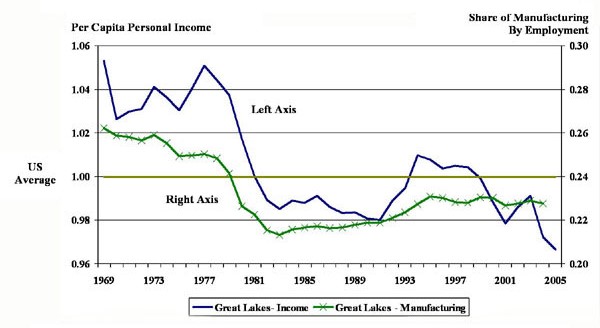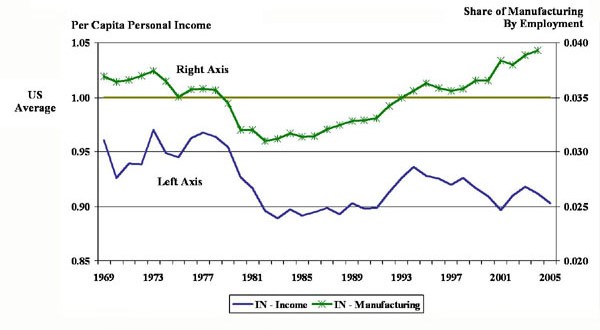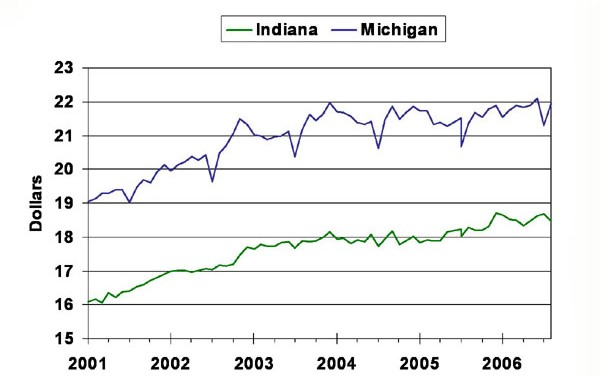Indiana observations
Each autumn, I have traveled down to the Indianapolis area to deliver a local perspective on the economy to the Indiana Economic Development Forum. This autumn, the Forum addresses the theme of “work force training and education.” As I survey Indiana’s economic performance over the past 15 years, it strikes me that Indiana is on the right track with its strategic focus on boosting work force training and education. So too, where feasible, an emphasis on technology transfer, firm growth, and entrepreneurial activity may be needed to create matching job opportunities for the more highly skilled Hoosiers.
Indiana and its neighboring Midwestern states rank near the top in manufacturing concentration. Even so, as the figure below shows, the deep recessions of the early 1980s sharply shifted the region’s share of manufacturing jobs elsewhere (right axis, green line). As the steel and auto industries waned here, the computer and military equipment industries grew elsewhere.
1. Regional manufacturing and personal income

2. Indiana manufacturing and personal income

The figure also reveals the period’s depressing effects on the region’s per capita income as a result of manufacturing job loss and slow recovery (left axis, blue line). Since then, per capita income, as compared to the national average, has not fully recovered in the Great Lakes region, nor in Indiana, for that matter.
However, Indiana’s job growth and share of manufacturing jobs have recently out-performed the surrounding region (bottom chart). Indeed, even though the level of jobs has declined, Indiana has exceeded its 1980s share of the nation’s manufacturing jobs. Consequently, while the relative per capita income in the Great Lakes region has taken a dive over the last few years, Indiana’s income has remained about the same in relation to the national average.
Something is going right in Indiana, or at least it is going a little better than in surrounding Midwestern states. But given the notably stronger performance gains in Indiana’s share of the nation’s manufacturing jobs, shouldn’t its per capita income be rising a bit, rather than being stuck in place?
The answer again likely lies in today’s broad economic trends. Indiana’s manufacturing wages lie below its Midwestern neighbors. This can be seen in the figure below, which illustrates the higher hourly earnings of production workers in Michigan versus Indiana. Perhaps the state’s favorable wage environment for employers, along with other business climate attractions, partly explain its job share gains in manufacturing, even as per capita income gains are not quite so robust.
3. Manufacturing — average hourly wage

Another reason for less robust progress in Indiana’s per capita income can be found in service sector versus manufacturing wage trends. While average wage levels in manufacturing tend to exceed average service sector wage rates in the nation, service sector wage growth has been catching up to manufacturing.
How can Indiana improve its living standards? In our market-oriented economy, higher wages and earnings are currently being paid to those with higher skills and education. For this reason, investment in education and work force training are one important part in achieving higher income for Hoosiers.
In addition to higher skills, there must be job opportunities available for those enhanced skills and training. Sometimes, such local job opportunities do emerge as new firms and capital investment migrate into states in search of favorable work force skills and education. However, in other instances, skilled workers move out of state in search of greater opportunity. To forestall this loss of skilled workers, Indiana and other states are pursuing not only work force training and education, but also local technology transfer from technical universities along with the encouragement of entrepreneurial ventures.








